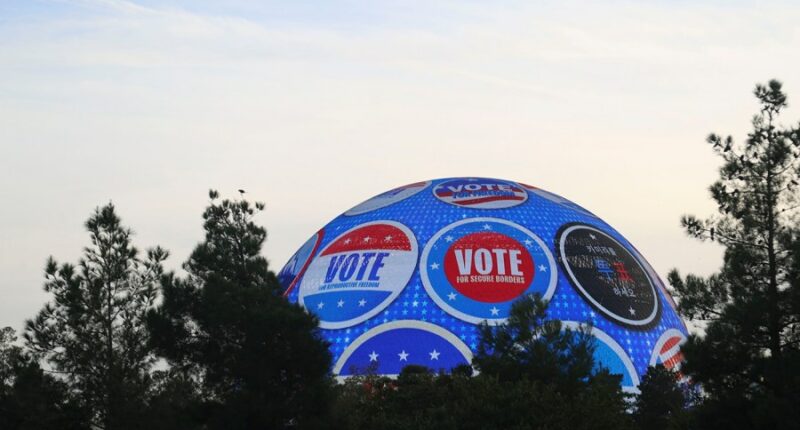Share this @internewscast.com

(The Hill) — Democrats are sounding the alarm on new data showing they are losing voters to Republicans across the country.
A revealing New York Times report on Wednesday highlighted that in the 30 states where voter registration is categorized by political party, Democrats have lost ground to Republicans in all states between the 2020 and 2024 elections.
In total, Republicans added up to 4.5 million voters compared to Democrats, creating a huge hold that could set Democrats back for years.
“I think it should be an alarm” for the Democratic Party, said party strategist Eddie Vale. “I think it’s a real problem.”
This emerging data coincides with Democrats’ attempts to escape the political wilderness after losing the presidency to Donald Trump and ceding control of both congressional chambers to the GOP.
California Governor Gavin Newsom has gained some traction by targeting Trump, emulating the former president’s style on social media, which has invigorated many within his party.
Nonetheless, the Democratic brand has suffered significant setbacks, with The New York Times data underscoring the notion that the party may have strayed from its path.
Vale noted that a span of voters, including people of different races and ages, were abandoning the party, according to the Times reporting.
He said his worry is that all of these different kinds of voters feel like the Democratic Party left them.
These voters “all shared the broader fact that they are working class and not feeling like we were talking to them or actually going to help them, so that needs to be fixed,” he said.
An additional Democratic strategist expressed dismay at the report, at a time when the party feels adrift, lacking both leadership and a compelling message to present to voters.
“Two things need to happen for Trump’s political movement to fail: Trump and MAGA popularity plummets and Democrats’ brand popularity rises,” the strategist said. “The former is happening but not the latter.”
“You have to have something clear to offer an alternative vision,” the strategist added. “The voter registration lag is directly related to this because the Democratic brand is flat. It’s one of the reasons why the most successful Democrats in this environment run against both parties.”
Democrats have been feeling dejected since their devastating defeat in November, when they lost control of not just the presidency but the House and the Senate, which they had previously controlled.
Recent polls show that Democrats view their party as weak. An Associated Press-NORC Center for Public Affairs Research poll in July revealed that about 1 in 5 Democrats described their party in a positive light.
And a poll by the Democratic super PAC Unite the Country obtained by The Hill last month showed that voters perceived the Democratic Party as “out of touch,” “woke” and “weak.”
The struggle to connect with voters has been a running theme for months, with even Democrats acknowledging that they have yet to put forward a compelling message.
A Wall Street Journal poll out late last month showed Democrats’ popularity had hit the lowest point in 35 years, as 63 percent of voters had an unfavorable view of the party. At the same time, 33 percent of those surveyed held a favorable view.
The drop in voter registration for Democrats “matches what we see in the polls,” said Republican strategist Susan Del Percio, who does not support Trump. “People are unsatisfied with what the Democrats are offering.”
“It shows how Democrats took things for granted and got out-hustled by Republicans, and I don’t say that with glee or anything else,” Del Percio added. “But the numbers are there, and this is proof in the pudding.”
A major Democratic donor was more scathing: “Our party sucks. Our leadership sucks. Our message sucks. Why would anyone want to be a Democrat?”
“We’re completely out of touch,” the donor said.
Democrats also say they are aware of voters’ perceptions and views of the party and have sought to make inroads with key demographics that have strayed from their party.
They have been conducting a series of postmortems and focus groups in an effort to win the voters back.
Steve Schale, the veteran Democratic strategist, said the only voter registration that has “really moved the needle in the last 20 years has been centered around the party and candidates” and that Democrats should return to that model.
“Not only does party-based voter registration accomplish the rote goal of registering voters, it also requires the kind of outreach in key communities that we have long rightly been criticized for abandoning,” Schale said. “But to this, donors have to be willing to support the DNC [Democratic National Committee] and state parties.”
“It won’t happen on its own,” Schale added.
At the same time, Vale cautioned that the Democratic Party should not simply mend what’s broken. They have to be forward-looking.
“We need to make sure that while we fix it we don’t only fight the last war and not be attuned to things possibly changing again,” Vale said. “Because we have already seen in a lot of polling that younger people, Latino and African American men are souring on Trump and that can be something that can be the leading edge of winning them back registration-wise.”
In the end, Democratic strategist Anthony Coley said, the numbers amount to trust with voters and “a larger problem with the Democratic brand.”
“Voters have run away from the party for a variety of reasons but trust — or the lack of it — tops the list,” Coley said. “Too many voters just don’t trust the Democratic Party to deliver on issues they care about.”











